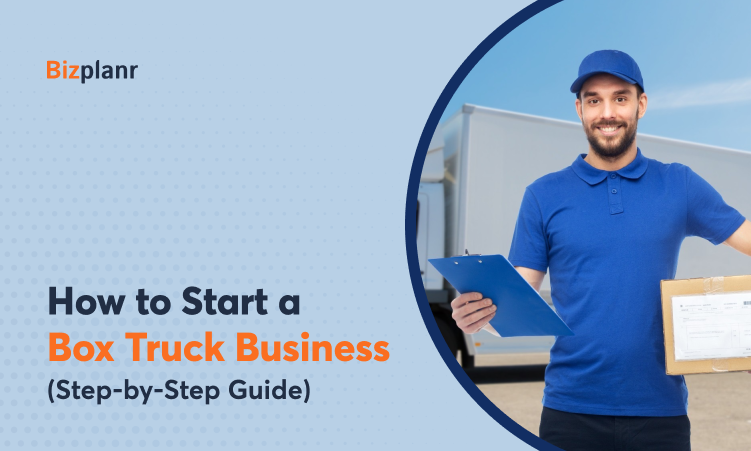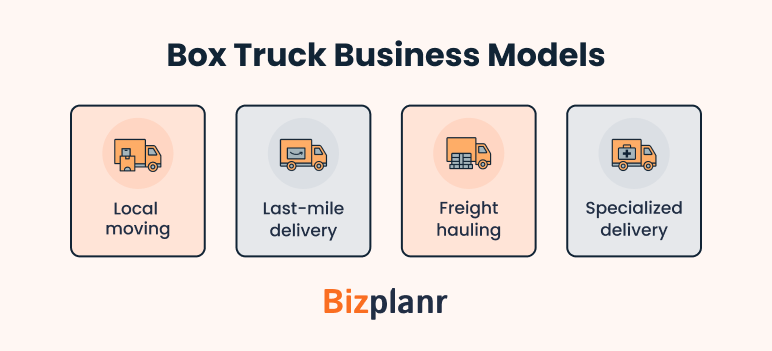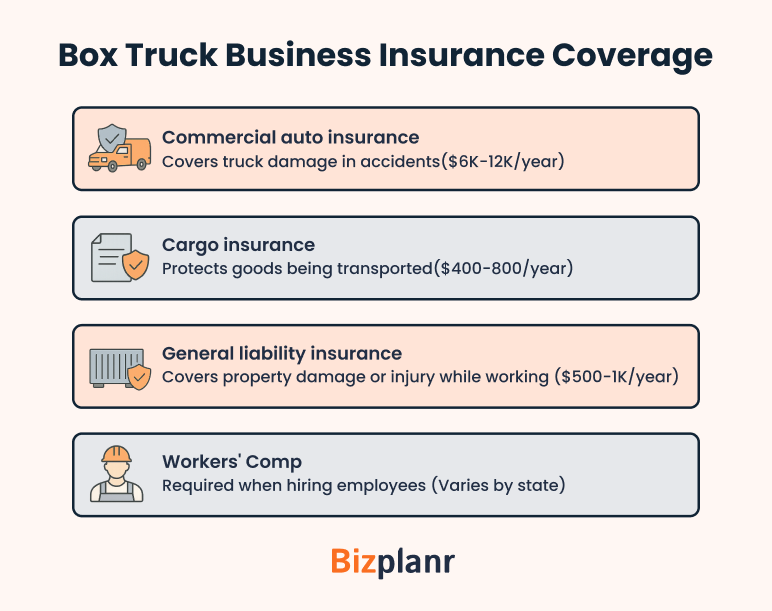Starting a box truck business isn’t just about buying a truck and slapping your logo on the side. It’s about spotting an opportunity in one of the most reliable corners of the transportation world—where small businesses, retail stores, and even individuals are always looking for someone to move goods quickly and efficiently.
As someone who spends a lot of time helping entrepreneurs turn big ideas into solid business plans, I can tell you this: Box truck businesses can be incredibly profitable—but only if you start with the right foundation. You’ll need to think beyond the truck itself. Like mapping out your services, understanding regulations, calculating startup costs, and figuring out how to land those first few contracts.
In this article, I’ll walk you through the essentials of how to start a box truck business. From licenses and equipment to marketing and financial planning, we’ll cover everything you need to know to turn your truck into a revenue-generating machine.
Key Takeaways
- Startup costs for a box truck business usually range from $10,000 to $50,000, depending on truck type, insurance, and permits.
- Choosing the right niche (local moving, freight hauling, or last-mile delivery) is crucial for steady work.
- Daily habits like tracking loads, keeping receipts, and maintaining your truck make a big difference in long-term success.
- Building a simple box truck business plan helps you stay organized, avoid rookie mistakes, and scale steadily.
Step 1: Decide what type of box truck business you’ll run
The first decision you need to make is what service you’ll actually offer with your box truck. I’ve seen many new owners skip this part and just take any load they can find. The problem is that this usually leads to long hours, low-paying jobs, and no real plan for a steady income.
From what I’ve noticed, the people who succeed usually pick a lane early on and build their business around it. Here are a few common routes:
1. Local moving services
If you live in a growing city where people are always shifting apartments, this can be steady work. But ensure to consider things like heavy lifting, needing extra labor help, and dealing with seasonal slowdowns.
2. Amazon Relay or last-mile delivery contracts
This option gives you a predictable flow of work, but it also comes with stricter requirements (clean driving record, insurance, ELD device, and often a 26-foot truck). If you want consistent loads without chasing clients, this is worth looking into.
3. Freight hauling for small businesses
Some local stores, furniture outlets, or even farms need deliveries but don’t work with big trucking companies. Building a relationship with 2–3 of these clients can keep your truck busy without relying only on load boards.
4. Specialized delivery
Think medical supplies, catering, or event equipment. These usually pay better per load but may require extra licensing or insurance.
On average, box truck loads have brought in around $2.20 to $3.20 per mile in recent years. What you actually earn depends on your market, the type of service you choose, and how steady your client base is.
Step 2: Research your market
Once you’ve decided on the type of box truck business you want to run, the next step is to look at your local market. I’ve seen too many people buy a truck first and only later realize that there isn’t enough steady work around them.
Doing a little research up front can save you from that mistake.
Start with the basics:
- Check how many moving or delivery services already operate within 30–50 miles.
- Look at the type of jobs they advertise. Are they focused on moving, last-mile delivery, or local freight?
- Pay attention to their pricing and how often they seem busy.
I’ve also found it helpful to talk directly to local businesses. A quick call to a furniture store, small warehouse, or catering company can tell you if they hire independent drivers. Many small businesses prefer flexible operators over larger carriers.
It also helps to think about the type of area you’re in:
- Growing suburbs usually mean steady demand for moving services.
- Cities with warehouses and distribution centers often have short-haul freight opportunities.
- Areas with strong eCommerce activity tend to have more last-mile delivery work.
One last thing I recommend is to look into requirements early. For example, if you’re planning on Amazon Relay, you’ll need commercial insurance, DOT compliance, and in many cases a 26-foot truck. Knowing the rules up front will help you avoid wasted effort later.
Contact larger freight handling companies like DHL, FedEx, UPS, USPS, etc., to see if they will hire you as an independent contractor.
Becoming an independent contractor for such big names will help you get established and become your initial income source. Something you’ll need to grow and survive (during tough times).
Step 3: Write a simple box truck business plan
I know when hearing “box truck business plan”, it sounds like something that takes weeks to write, but it really doesn’t have to be complicated.
For a box truck business, what matters most is putting your ideas on paper so you have a clear direction. Too many owners jump in without a plan and then struggle to track expenses, set rates, or figure out how to grow.
Here’s what I suggest including in a simple box truck business plan:
- Services you’ll offer
- Your target market
- Startup costs and budget
- Pricing strategy
- Marketing approach
- Goals for the first few years
A one- or two-page box truck business plan is more than enough at an early stage. You don’t need a 20-page report unless you’re applying for a loan. The point is to have a roadmap so you’re not guessing at every decision.
Get Your Business Plan Ready In Minutes
Answer a few questions, and AI will generate a detailed business plan.
Step 4: Budget your startup costs
Before you jump in, have a clear picture of your box truck startup costs. I’ve noticed that new owners often underestimate how much they’ll spend in the first few months, and that can lead to cash flow headaches.
Writing down your numbers ahead of time gives you a realistic view of what you’ll need to get rolling. Here are the main expenses to think about: Upfront and recurring costs.
| Expense Category | Estimated Cost Range | Notes | |
|---|---|---|---|
| Upfront Costs | Truck purchase/lease | $25,000-$40,000 (purchase) or $1,000-$1,500/mo lease | Biggest upfront cost; lease lowers entry cost, but raises monthly expenses |
| Insurance | $6,000-$12,000 per year | Varies by driving record, state, and coverage level | |
| Permits & registration | $500-$1,000 | DOT number, MC authority (if crossing state lines), business license | |
| Upfront + Recurring Costs | Equipment & supplies | $1,000-$2,000 | Dollies, blankets, ratchet straps, GPS/ELD device |
| Recurring Costs | Maintenance & repairs | $200-$400 per month | Oil changes, tires, unexpected repairs |
| Fuel | Varies | One of your largest recurring expenses | |
| Marketing | $500-$1,000 | Website, business cards, online ads |
Most operators spend between $30,000-$50,000 to get their box truck business running. Your exact number depends on whether you buy or lease, the condition of your truck, and how aggressively you market in the beginning.
The key isn’t just writing down the numbers once but updating them as you go. Many small trucking businesses fail because they don’t track expenses closely enough.
Step 5: Set up your business legally
This is the part most people want to skip, but trust me, it’s worth doing right at the start. Making your box truck business official keeps you out of trouble later and makes your business professional.
I’ve seen new owners try to run things under the table, and it almost always catches up with them, usually in the form of fines or an insurance headache.
Here’s the basic checklist that is recommended to follow:
- Pick a business structure: An LLC is usually the go-to for box truck businesses because it protects your personal assets if something goes wrong.
- Register your business name: Even if you’re starting small, having a proper business name makes you more credible.
- Get an EIN: This is free from the IRS and basically works like a tax ID for your business. You’ll need it for banking and taxes.
- Apply for a DOT or MC number (if required): If you’re crossing state lines or hauling certain types of freight, you’ll need one of these. Local-only routes might just need a DOT number.
- Check local permits: Every state (and sometimes city) has its own rules for commercial vehicles. A quick call or website check saves a lot of future stress.
- Open a business bank account: This one seems small, but it makes your finances so much cleaner. Plus, it helps if you ever apply for business credit or loans.
When I’ve looked at box truck businesses that grew quickly, almost all of them had their legal setup done early. It’s not the fun part of the journey, but it lays the groundwork for everything else.
Step 6: Get insurance & protection
Insurance is one of those things every box truck owner needs but few enjoy shopping for. It can feel like just another bill, but the reality is that it’s what keeps the business safe if something goes wrong. One accident or theft without proper coverage can wipe out months of hard work.
The main types of insurance most box truck businesses consider include:
- Commercial auto insurance – Covers the truck itself in case of accidents.
- Cargo insurance – Protects the goods being hauled. Some contracts won’t even look at an operator without this.
- General liability insurance – Helps cover damage or injury caused while working, like accidentally scratching walls during a delivery.
- Workers’ comp (if employees are hired) – Required in many states once there’s a team on payroll.
It’s also smart to think about non-insurance protection: Installing GPS trackers, dash cams, and secure locks.
The right coverage can be expensive upfront. But it builds credibility with clients and prevents the kind of financial hit that could end the business before it has a chance to grow.
Step 7: Acquire your box truck
The biggest expense in starting a box truck business is, of course, the truck itself. There’s no single “right” way to get one; it really depends on budget, credit, and how much risk you feel comfortable with.
Some of the options most new operators consider:
| Option | Pros | Cons |
|---|---|---|
| Buying new | Reliable, under warranty, fewer breakdowns. | Higher monthly payments, bigger upfront commitment. |
| Buying used | Lower upfront cost, lots of choices available. | Risk of hidden repairs, needs a thorough inspection by a mechanic. |
| Leasing | Predictable costs, no long-term ownership hassles. | Mileage limits, truck must be returned in good condition. |
| Renting short-term | Good for testing the waters before committing. | More expensive over time, not a long-term solution. |
When picking a truck, size matters. Many contracts (like Amazon Relay) require a 26-foot box truck, but local moving or small business deliveries can often be done with a 16 to 20-foot truck.
I always suggest looking beyond just the sticker price. Fuel efficiency, maintenance history, and even small things like liftgate condition can make a big difference in daily operations.
Step 8: Equip and set up your operations
The next step is making sure the truck is properly equipped for the type of work planned. A box truck on its own is just the start; small upgrades and tools can make jobs smoother, faster, and more professional.
At the very least, most operators invest in:
- Dollies and hand trucks for moving heavy items without injury.
- Moving blankets and straps to keep loads secure and prevent damage.
- Use GPS or route-planning apps to save time and fuel.
Depending on the type of box truck business, other tools may be worth adding.
For example, a liftgate is almost essential when hauling furniture or appliances. Cargo shelving can help organize smaller deliveries like catering or medical supplies.
Keeping extra gloves, reflective vests, and a basic repair kit in the truck also helps avoid downtime on the road. In the long run, being well-prepared not only makes daily work easier but also leaves a better impression on clients.
Step 9: Find loads and clients
Getting steady work is where a box truck business really comes to life. At first, most people start with load boards (like DAT or Truckstop) to pick up jobs quickly. The pay can vary, but it’s a good way to stay busy while building connections.
Over time, the goal is to land direct clients so you’re not always chasing loads. This could mean:
- Partnering with local furniture or appliance stores
- Offering moving help in growing neighborhoods
- Talking to small warehouses or retailers who need regular deliveries
Some operators also try Amazon Relay or other last-mile delivery contracts for consistent work, though these come with stricter requirements.
The key is to mix short-term jobs with long-term relationships. Once a few repeat clients are on board, income becomes much more predictable.
Step 10: Launch and manage daily operations
This is where everything comes together: The truck, the equipment, the plan, and the clients.
Daily operations are all about consistency. Keep the truck maintained, track expenses, stay on top of paperwork, and deliver loads on time. Simple!
From what I’ve seen, these small habits make the biggest difference. A quick truck check every morning before heading out. Keeping receipts in one place so they don’t get lost. Using a simple system, whether it’s a spreadsheet or an app, to track jobs and payments. These little routines save a lot of headaches later.
Remember: If people know they can rely on your box truck business to show up on time and handle their goods with care, word of mouth will do half the marketing for you.
5 Common mistakes to avoid (and fixes)
Every box truck business faces a learning curve, and some mistakes are more common than others. The key is recognizing them early, so you can implement simple fixes.
1. Underestimating local regulations and permits
Most new owners think, “I’ve got a CDL, I’m good to go.” Not quite. Every city and state has different requirements—some municipalities require special parking permits for commercial vehicles, others have strict weight restrictions on certain routes. Overlooking these can lead to surprise fines or downtime.
Fix: Before buying your first truck, map your target service area and check with both the state DOT and local municipalities for operating requirements. Build these costs into your startup plan so they don’t catch you off guard.
2. Ignoring seasonal demand fluctuations
Many beginners assume consistent year-round work. In reality, demand often spikes during retail seasons (holiday shopping, back-to-school) and drops sharply after. If you base your cash flow forecasts on the “busy months,” you’ll feel the pinch later.
Fix: Use conservative revenue estimates in your business plan and set aside a buffer fund for slow months. Better yet, diversify your contracts (e.g., moving services, small business deliveries, retail overflow) to keep trucks rolling all year.
3. Buying the wrong box truck type
A rookie mistake? Grabbing the cheapest truck available.
But the difference between a 16-foot and a 26-foot box truck isn’t just size—it changes your operating costs, insurance rates, and the type of contracts you can bid for. Too small, and you’ll miss out on lucrative jobs. Too big, and you’ll waste on fuel and maintenance.
Fix: If you’re targeting local furniture stores, pick bigger trucks. If you’re focusing on last-mile e-commerce deliveries, a smaller truck is more profitable. Basically, align your truck choice with your business plan—not the other way around.
4. Overlooking the power of direct contracts
New box truck owners often rely heavily on load boards. While they can get you started, the margins are razor-thin and competition is brutal.
The real money? Comes from securing long-term contracts with businesses that need regular deliveries.
Fix: From day one, build relationships with local retailers, wholesalers, and moving companies. Even one steady contract can stabilize your cash flow far better than chasing random one-off gigs. Use your business plan to map out potential industries to target.
5. Forgetting to price in downtime and deadhead miles
Here’s one most first-timers don’t think about: You don’t always get a return load. That means your truck is burning fuel and time on the way back empty—a.k.a. deadhead miles.
Many entrepreneurs underestimate how much this eats into profit.
Fix: Factor in average deadhead mileage when setting your rates. Or, better, plan your routes and schedule pickups strategically to reduce empty returns. Some owners even collaborate with other truckers to “swap loads” and minimize wasted miles. 💡
Conclusion
Yes, from finding loads and clients to keeping your truck in good shape, there’s plenty to handle when starting a box truck business. But it’s possible. The best approach is to take it one step at a time and adjust as you learn.
It also becomes easier when you have a basic business plan in place. It doesn’t have to be complicated, just a clear outline of your services, clients, costs, and how you’ll get loads. Tools like Bizplanr can help you stay organized.
With patience and steady planning, your box truck business can grow into a solid source of income.
Get Your Business Plan Ready In Minutes
Answer a few questions, and AI will generate a detailed business plan.
Frequently Asked Questions
Do I need a CDL (Commercial Driver’s License) for a box truck?
Not always. If your truck is under 26,000 pounds GVWR, you can usually get by with a regular driver’s license. That’s why a lot of first-time owners start with smaller trucks—it lowers the entry barrier. But once you move into bigger trucks or heavier loads, a CDL becomes a must. Plus, some clients simply prefer working with CDL drivers, so having one can give you an edge even if it’s not required.
Can a box truck business be profitable?
It definitely can, but it’s not an “easy money” kind of business. On average, trucking companies make 2% to 8% profit, which sounds slim, but with steady loads and smart management, those numbers add up.
The key is running lean: plan your routes to cut down on empty miles, stay on top of truck maintenance, and keep your invoicing tight so cash doesn’t get stuck. If you do those things right, a single truck can become a solid, steady income stream—and even the foundation to grow into a fleet.
Do I need a box truck business plan?
Yes, even a simple box truck business plan makes a big difference. It helps you stay clear on the types of loads you’ll take, your costs, and how you plan to grow. To make things simple, you can always use business plan generators.
Can I run a box truck business part-time?
Yes, it’s actually very common to start part-time and only go full-time once you’ve got a few steady contracts lined up. It’s only smart to avoid too much risk.
However, our clients expect reliability. Don’t miss deliveries or cancel last minute because of your other job. Word will get around fast.







